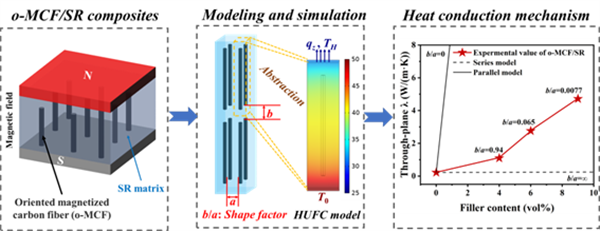11. Thermally conductive silicone rubber composites with vertically oriented carbon fibers: A new perspective on the heat conduction mechanism
作者:Dong-Liang Ding, Ruo-Yu Huang, Xu Wang, Shi-Yu Zhang, Ya Wu, Xu-Ao Zhang Guang-Zhao Qin*, Zhen-
關(guān)鍵字:Carbon fiber, Silicone rubber, Magnetic field,Thermal conductivity, Finite element, Shape factor
論文來(lái)源:期刊
具體來(lái)源:Chemical Engineering Journal 2022, 441, 136104.
發(fā)表時(shí)間:2022年
The continual increase in power density and consumption of modern electronic devices calls for high-performance thermal interface materials (TIMs). In this work, silicone rubber composites with vertically oriented magnetic carbon fibers (o-MCF/SR) were successfully prepared via the cast molding and filler orientation upon uniform magnetic field in a vacuum environment. The through-plane thermal conductivity of o-MCF/SR composites showed an unusual power-law growth with increasing MCF loading. At a 9 vol% MCF loading, the o-MCF/SR composite exhibited a maximum through-plane thermal conductivity of 4.72 W/(m·K) with 2045.5 % TCE, about 3.55 W/(m·K) higher than that of SR composites with randomly dispersed MCF (λ=1.17 W/(m·K), TCE = 431.8 %). To reveal the underlying through-plane heat conduction mechanism of o-MCF/SR composites, finite element simulation combined with classical effective medium theory model and machine learning method was used. A homogeneous unit fiber-filled composite (HUFC) was modelled, and a new parameter influencing the through-plane thermal conductivity, i.e., shape factor (b/a), was introduced here for the first time. Theoretically, this shape factor was dependent on the filler content and indirectly reflected the assembly of matrix and 1D filler in HUFC fit to a parallel-series hybrid model. Furthermore, a decrease of b/a was practically found with increasing MCF loading, and the dominant series-type assembly gradually transformed to parallel-type assembly of the o-MCF/SR composites. This work not only developed a method to fabricate desirable TIMs that hold great promise for advanced thermal management, but also introduced a new parameter to reveal the underlying mechanism for heat conduction capacity of polymer composites.
